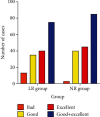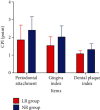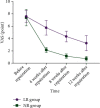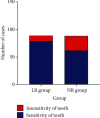Analysis of Cosmetic Effect of Nanocomposite Resin on Anterior Teeth
- PMID: 34887941
- PMCID: PMC8651348
- DOI: 10.1155/2021/7367320
Analysis of Cosmetic Effect of Nanocomposite Resin on Anterior Teeth
Abstract
The problems of anterior teeth include dental plaque, dental caries, and fracture, which are usually treated with common composite resin clinically. Although good repair effect can be achieved, patients are prone to anterior tooth sensitivity after surgery. Therefore, the purpose of this study is to analyze the cosmetic effect of nanocomposite resin on anterior teeth. Up to 176 patients (176 teeth) undergoing anterior dental cosmetic restoration in our hospital were selected and assigned to the LR group (n = 88) and the NR group (n = 88) according to patients' voluntary choice of prosthetic materials. The LR group was cured with light-cured composite resin, while the NR group was cured with nanocomposite resin. By comparing the related indexes of patients in the two groups, it was discovered that in the NR group, the excellent and good rate and patients' evaluation of the repair effect were higher, while the periodontal attachment, gingival index, dental plaque index, VAS score, and the incidence of tooth sensitivity were lower, all P < 0.05. The results indicated that the nanocomposite resin had significant cosmetic effect on anterior teeth and had application value.
Copyright © 2021 Yubo Wang et al.
Conflict of interest statement
The authors declare no conflict of interest.
Figures







Similar articles
-
Clinical Performance and Epidemiologic Aspects of Fractured Anterior Teeth Restored with a Composite Resin: A Two-Year Clinical Study.J Prosthodont. 2019 Jan;28(1):e204-e209. doi: 10.1111/jopr.12645. Epub 2017 Sep 27. J Prosthodont. 2019. PMID: 28960769
-
One-year Clinical Evaluation of Resin Composite Restorations of Noncarious Cervical Lesions in Smokers.J Adhes Dent. 2015 Aug;17(5):405-11. doi: 10.3290/j.jad.a35009. J Adhes Dent. 2015. PMID: 26525004 Clinical Trial.
-
[Clinical evaluation of gingival composite resin restoring cervical defects in anterior teeth].Beijing Da Xue Xue Bao Yi Xue Ban. 2011 Feb 18;43(1):44-7. Beijing Da Xue Xue Bao Yi Xue Ban. 2011. PMID: 21321618 Chinese.
-
Quality and Survival of Direct Light-Activated Composite Resin Restorations in Posterior Teeth: A 5- to 20-Year Retrospective Longitudinal Study.J Prosthodont. 2019 Jan;28(1):e195-e203. doi: 10.1111/jopr.12630. Epub 2017 May 17. J Prosthodont. 2019. PMID: 28513897 Review.
-
Simplified techniques for the placement of stratified polychromatic anterior and posterior direct composite restorations.Compend Contin Educ Dent. 2003 Feb;24(2 Suppl):19-25. Compend Contin Educ Dent. 2003. PMID: 12793209 Review.
References
-
- Juez M., Ballester M. L., Berastegui E. <i>In vitro</i> comparison of apical microleakage by spectrophotometry in simulated apexification using white mineral trioxide aggregate, TotalFill bioceramic root repair material, and BioDentine. Journal of Conservative Dentistry . 2019;22(3):237–240. doi: 10.4103/JCD.JCD_19_19. - DOI - PMC - PubMed
Publication types
MeSH terms
Substances
LinkOut - more resources
Full Text Sources

